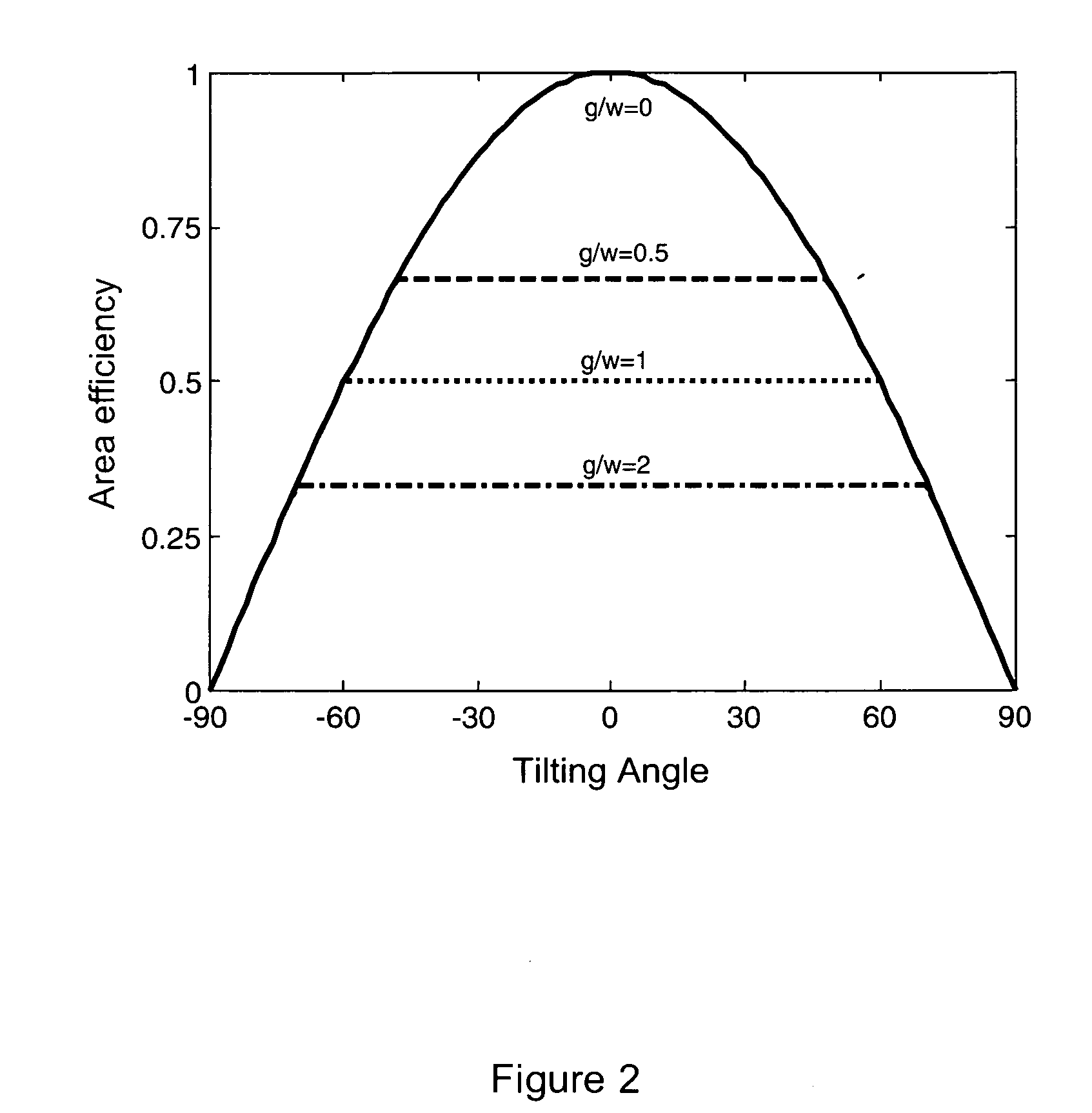[0012] Embodiments of the present invention are directed to a
solar module packaging and
assembly of a plurality of linear solar concentrators, the
solar module and
concentrator assembly system capable of converting
solar energy into
electricity. The
assembly can be embedded in a sealed structure that is similar in dimensions to conventional terrestrial weather-proofed modules. Each individual linear
concentrator can possess a freedom of
axial rotation while being sealed inside the fixed structure, the
axial rotation providing the
mechanics to realize solar tracking collectively for an array of concentrator assemblies. With such an arrangement, the frame holding the concentrator array can remain stationary, so space does not need to be dedicated to pivoting or the frame. The
solar module can be constructed in such a way that
sun tracking solar concentrators can be pivotably mounted and enclosed inside the module to reduce the number of solar cells needed, while simultaneously enhancing photovoltaic efficiency in a module configured as a fixed flat-panel structure. The concentrator assemblies used in the array can be composed of optical elements and solar
irradiation receivers for converting
solar energy into
electricity.
[0015] The solar assembly tracking mechanism can include, e.g., an array of light detectors that provide a first pattern of
detector signals when the concentrator aperture normals are aligned with the sun and a second different pattern of
detector signals when the normals are not aligned with the sun. The different pattern can be interpreted according to a defined
algorithm to determine the relative angle and direction the module must be turned to provide alignment with the sun. In particular embodiments, power used to drive the tracking mechanism adjustments can be derived from one or more non-concentrated, flat-plate solar cells. In this way, power can be provided to tracking motors even when the concentrators are not aligned with the sun.
[0016]
Energy conversion efficiency of the solar modules can be enhanced by including both photovoltaic and thermoelectric receivers in a
hybrid system. For example, the array of receivers can be configured with the photovoltaic receivers mounted in thermoconductive contact with the thermoelectric receivers so that the photovoltaic receivers can convert
usable light into
electricity while the thermoelectric receivers cool the
system and convert heat to additional electricity. Alternately, the solar modules can include devices to refract and direct long wavelengths to thermoelectric receivers while allowing
usable visible and UV frequencies to strike photovoltaic receivers. For example, the concentrator assemblies can include a
prism,
diffraction grating or optical
band pass filter to direct visible light to the photovoltaic
receiver array and to direct
infrared light to the array of thermoelectric receivers.
[0017] The invention includes methods and systems to remove
excess heat from modules to reduce thermal stresses and to enhance the efficiency of the solar receivers. In a basic embodiment, the backing plate of the module can act as a
heat sink in thermal conductive contact with the array of receivers to remove heat during operation. In embodiments wherein more rapid heat removal is desired, the solar module can include a
coolant fluid in a conduit mounted in thermoconductive contact with the photovoltaic receivers and / or the thermoelectric receivers. The
coolant can optionally flow in a
coolant loop, e.g., to an external
heat exchanger to release heat from the solar module into
ambient air.
[0021] In an embodiment of systems of the invention with
moisture abatement capabilities, a vent channel between the trap and external environment can be long and thin (e.g., 6 inches, 12 inches, 24 inches or more long, and 1 mm, 0.5 mm, 0.25 mm or less internal
diameter) to reduce the intrusion of
water vapor into the
water trap by
diffusion. It is preferred embodiment, the vent channel is coiled to make it more compact. For example, a
solar concentrator system with
moisture abatement capability can include a sealed solar concentrator module having a channel fluidly connecting an internal space of the module to an external environment through a
water vapor trap, and the channel between the vapor trap and the external environment can include a coiled tube with an internal
diameter of less than 0.5 mm. In preferred embodiments of water abatement methods, the
water trap can be heated at appropriate times. For example, the invention includes methods of abating condensation inside solar concentrator module by providing a channel fluidly connecting an internal space of the module to an external environment through a
water vapor trap, and heating the vapor trap when air is flowing from the
interior space to the external environment. DEFINITIONS
 Login to View More
Login to View More  Login to View More
Login to View More 


